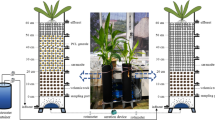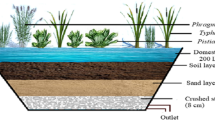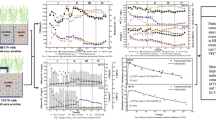Abstract
Clogging is a major operational and maintenance issue associated with the use of constructed wetlands. In this study, four lab-scale vertical flow constructed wetlands (VFCW) were used to fully understand the development mechanisms of various types of clogging and their recovery characteristics. The VFCWs were fed with glucose solution, starch suspension with and without bacteriostat, glucose, and starch mixed solution, respectively, to simulate Bio-clogging, organic particle clogging (Op-clogging), inert particle clogging (Ip-clogging), and the combination of Bio-clogging and Op-clogging (C-clogging). Resting operations with water decline were applied to relieve the clogging in the VFCWs. The results indicate that Op-clogging occurred first, followed by C-clogging and Bio-clogging. Ip-clogging took the longest time to develop and did not occur by the end of this study. The microscope analysis found that the extracellular polymeric substances (EPS) bonded the starch particles together to form a dense membrane-like structure and promoted the clogging process. In addition, surface clogging was observed in all four experimental beds. Op-clogging occurred much closer to the surface than those caused by soluble organic matter and inert particles. Furthermore, the growth of biofilm caused significant decline in hydraulic conductivity, whereas its influence on porosity was relatively slight. Moreover, applying resting operation with water decline was effective for recovery from Bio-clogging, Op-clogging, and C-clogging in VFCWs except for Ip-clogging. The results also implied the recovery rates through applying resting operation with water decline were much higher than that with constant water level.










Similar content being viewed by others
References
Brangarí AC, Sanchez-Vila X, Freixa A, Romaní AM, Rubol S, Fernàndez-Garcia D (2017) A mechanistic model (BCC-PSSICO) to predict changes in the hydraulic properties for bio-amended variably saturated soils. Water Resour Res 53(1):93–109
Caruso A, Boano F, Ridolfi L, Chopp DL, Packman A (2017) Biofilm-induced bioclogging produces sharp interfaces in hyporheic flow, redox conditions, and microbial community structure. Geophys Res Lett 44(10):4917–4925
Caselles-Osorio A, Puigagut J, Segú E, Vaello N, Granés F, García D, García J (2007) Solids accumulation in six full-scale subsurface flow constructed wetlands. Water Res 41(6):1388–1398
Conley LM, Dick RI, Lion LW (1991) An assessment of the root zone method of wastewater treatment. J Water Pollut Control Fed 63(3):239–247
Du M, Xu D, Trinh X, Liu S, Wang M, Zhang Y, Wu Z (2016) EPS solubilization treatment by applying the biosurfactant rhamnolipid to reduce clogging in constructed wetlands. Bioresour Technol 218:833–841
Fu G, Zhang J, Chen W, Chen Z (2013) Medium clogging and the dynamics of organic matter accumulation in constructed wetlands. Ecol Eng 60:393–398
Funami T, Nakauma M, Noda S, Ishihara S, Asai I, Inouchi N, Nishinari K (2008) Effect of some anionic polysaccharides on gelatinization and retrogradation behaviors of wheat starch: soybean-soluble polysaccharide and gum Arabic. Food Hydrocoll 22:1528–1540
García J, Rousseau DPL, Morató J, Lesage E, Matamoros V, Bayona JM (2010) Contaminant removal processes in subsurface-flow constructed wetlands: a review. Crit Rev Environ Sci Technol 40(7):561–661
Griffin PWLC, Ackermann K (2008) Changes in the use, operation and design of sub-surface flow constructed wetlands in a major UK water utility. Proceedings of 11th International Conference on Wetland Systems for Water Pollution Control. pp 419–426
Hans-Curt F, Jost W (2010) The biofilm matrix. Nat Rev Microbiol 8(9):623–633
Hua GF, Zhu W, Zhao LF, Huang JY (2010a) Clogging pattern in vertical-flow constructed wetlands: insight from a laboratory study. J Hazard Mater 180(1–3):668–674
Hua GF, Zhu W, Zhao LF, Zhang YH (2010b) Applying solubilization treatment to reverse clogging in laboratory-scale vertical flow constructed wetlands. Water Sci Technol 61(6):1479–1487
Hua GF, Li L, Zhao YQ, Zhu W, Shen JQ (2013a) An integrated model of substrate clogging in vertical flow constructed wetlands. J Environ Manag 119:67–75
Hua GF, Zhu W, Shen JQ, Zhang YH, Zeng YT (2013b) Role of biofilm in clogging process in vertical flow constructed wetland. Appl Eng Agric 29(1):61–66
Hua G, Zeng Y, Zhao Z, Cheng K, Chen G (2014) Applying a resting operation to alleviate bioclogging in vertical flow constructed wetlands: an experimental lab evaluation. J Environ Manag 136(8):47–53
Knowles P, Dotro G, Nivala J, García J (2011) Clogging in subsurface-flow treatment wetlands: occurrence and contributing factors. Ecol Eng 37(2):99–112
Li HZ, Wang S, Jianfeng FY, Xu ZX, Jin W (2011) A practical method for the restoration of clogged rural vertical subsurface flow constructed wetlands for domestic wastewater treatment using earthworm. Water Sci Technol 63(2):283–290
Mahjoub H, Tapias JC, Lovera R, Rivero L, Font X, Casas A (2016) Assessing clogging processes caused by biofilm growth and organic particle accumulation in constructed wetlands using time-lapse electrical resistivity tomography method. Paper presented at the EGU General Assembly Conference
Mcswain BS, Irvine RL, Hausner M, Wilderer PA (2005) Composition and distribution of extracellular polymeric substances in aerobic flocs and granular sludge. Appl Environ Microbiol 71(2):1051–1057
Nivala J, Rousseau DP (2009) Reversing clogging in subsurface-flow constructed wetlands by hydrogen peroxide treatment: two case studies. Water Sci Technol 59(10):2037–2046
Pedescoll A, Uggetti E, Llorens E, Granés F, García D, García J (2009) Practical method based on saturated hydraulic conductivity used to assess clogging in subsurface flow constructed wetlands. Ecol Eng 35(8):1216–1224
Philippe Vandevivere PB (1992) Effect of bacterial extracellular polymers on the saturated hydraulic conductivity of sand columns. Appl Environ Microbiol 5(58):1690–1698
Radjenović J, Matošić M, Mijatović I, Petrović M, Barceló D (2008) Membrane bioreactor (MBR) as an advanced wastewater treatment technology. Springer, Berlin Heidelberg
Segismundo E, Kim L, Jeong S, Lee B (2017) A laboratory study on the filtration and clogging of the sand-bottom ash mixture for stormwater infiltration filter media. Water-Sui 9(1):32
Shutes PCGJ (1996) Reed beds and constructed wetlands for wastewater treatment. WRc Publications, Swindon 184 pp. plus datadiskette
Tang P, Yu B, Zhou Y, Zhang Y, Li J (2017a) Clogging development and hydraulic performance of the horizontal subsurface flow stormwater constructed wetlands: a laboratory study. Environ Sci Pollut Res Int 24(10):9210–9219
Tang P, Xiang Z, Yu B, Zhou Y (2017b) Effect of resting operation on recovery of clogging and its dynamics for virtual flow constructed wetlands. T Chinese Soc Agric Eng 33(20):234–240
Thullner M, Zeyer J, Kinzelbach W (2002) Influence of microbial growth on hydraulic properties of pore networks. Transp Porous Media 49(1):99–122
Tong W, Zhu W, Ruan A (2007) Primary study of clogging mechanisms of substrates in vertical flow constructed wetland. Journal of Lake Sciences 19(1):25–31
Vandevivere P, Baveye P (1992) Saturated hydraulic conductivity reduction caused by aerobic bacteria in sand columns. Soil Sci Soc Am J 56(1):1–13
Varga DDL, Díaz MA, Ruiz I, Soto M (2013) Avoiding clogging in constructed wetlands by using anaerobic digesters as pre-treatment. Ecol Eng 52(2):262–269
Xia L, Zheng X, Shao H, Xin J, Peng T (2014) Influences of environmental factors on bacterial extracellular polymeric substances production in porous media. J Hydrol 519:3153–3162
Xia L, Zheng X, Shao H, Xin J, Sun Z, Wang L (2016) Effects of bacterial cells and two types of extracellular polymers on bioclogging of sand columns. J Hydrol 535:293–300
Ye J, Li H, Zhang C, Ye C, Han W (2014) Classification and extraction methods of the clog components of constructed wetland. Ecol Eng 70(70):327–331
Yousif OS, Karakouzian M, Rahim NO, Rashed KA (2017) Physical clogging of uniformly graded porous media under constant flow rates. Transp Porous Media 120(3):643–659
Zhao L, Zhu W, Tong W (2009) Clogging processes caused by biofilm growth and organic particle accumulation in lab-scale vertical flow constructed wetlands. J Environ Sci (China) 21(6):750–757
Zhong X, Wu Y (2013) Bioclogging in porous media under continuous-flow condition. Environ Earth Sci 68(8):2417–2425
Zhong X, Wu Y, Xu Z (2013) Bioclogging in porous media under discontinuous flow condition. Water Air Soil Pollut 224(5):1543
Acknowledgements
This study is supported by the China Major Science and Technology Program for Water Pollution Control and Treatment [2011ZX07301-004].
Author information
Authors and Affiliations
Corresponding author
Additional information
Responsible editor: Philippe Garrigues
Rights and permissions
About this article
Cite this article
Zhou, Y., Luo, S., Yu, B. et al. A comparative analysis for the development and recovery processes of different types of clogging in lab-scale vertical flow constructed wetlands. Environ Sci Pollut Res 25, 24073–24083 (2018). https://doi.org/10.1007/s11356-018-2418-z
Received:
Accepted:
Published:
Issue Date:
DOI: https://doi.org/10.1007/s11356-018-2418-z




